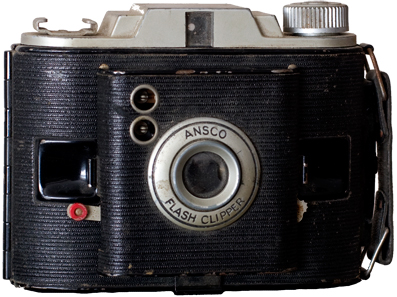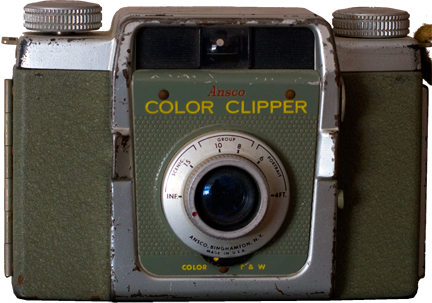


Approx. dates of manufacture: 1940s - 1950s
Approx. street value: very low
It takes a certain level of fool to have an Ansco Clipper. It takes a whole 'nother level of fool entirely to have two.
In my defense, these were acquired back when I was a kid and I bought anything I saw that was priced under $5.
These are essentially the same camera so they're sharing the same page. Ansco made the original Clipper and it was something of a success, so they did what everyone did; they would make small updates and give it a new name and release it. So there's the original Clipper, then they added flash synch and called it the Clipper Flash. They're essentially identical other than the flash synch sockets. They have that late art deco styling with the horizontal corduroy fabric covering. The lens is fixed. So all you do is pull the front standard out and lock it into place, and flip the shutter lever on the side. There's precious little else left.
 After that there's a Clipper Special, which I don't have: it appears to be a Clipper with an adjustable shutter, diaphram and lens focus.
After that there's a Clipper Special, which I don't have: it appears to be a Clipper with an adjustable shutter, diaphram and lens focus.
Lastly there's the Color Clipper, which is the original Clipper but slightly redesigned. The major difference is the focusable lens and green fabric covering instead of black. The flash synch sockets have been moved to the side and the accessory shoe is gone. The accessory flash unit mounted directly onto the camera.
A nice change is that they moved the shuller release behind the front standard and made it a paddle, so it's big and easy to press. This would be a good feature if you have to wear thick gloves.
And then there's a little switch under the lens that says "color" and "B&W". That's the aperture setting; on any other camera it would be "Normal" and "Bright." Color film was slow (Kodachrome was ASA 10 for years), but standard B&W film was relatively fast (ASA 125), so you select the large aperture, "color" for slow color film and the smaller aperture for fast B&W film.
This camera feeds the film sideways so you get 16 shots on big-ass 616 film, so even the economy format still yielded relatively large negatives.
Camera manual: Orphan Cameras.com
